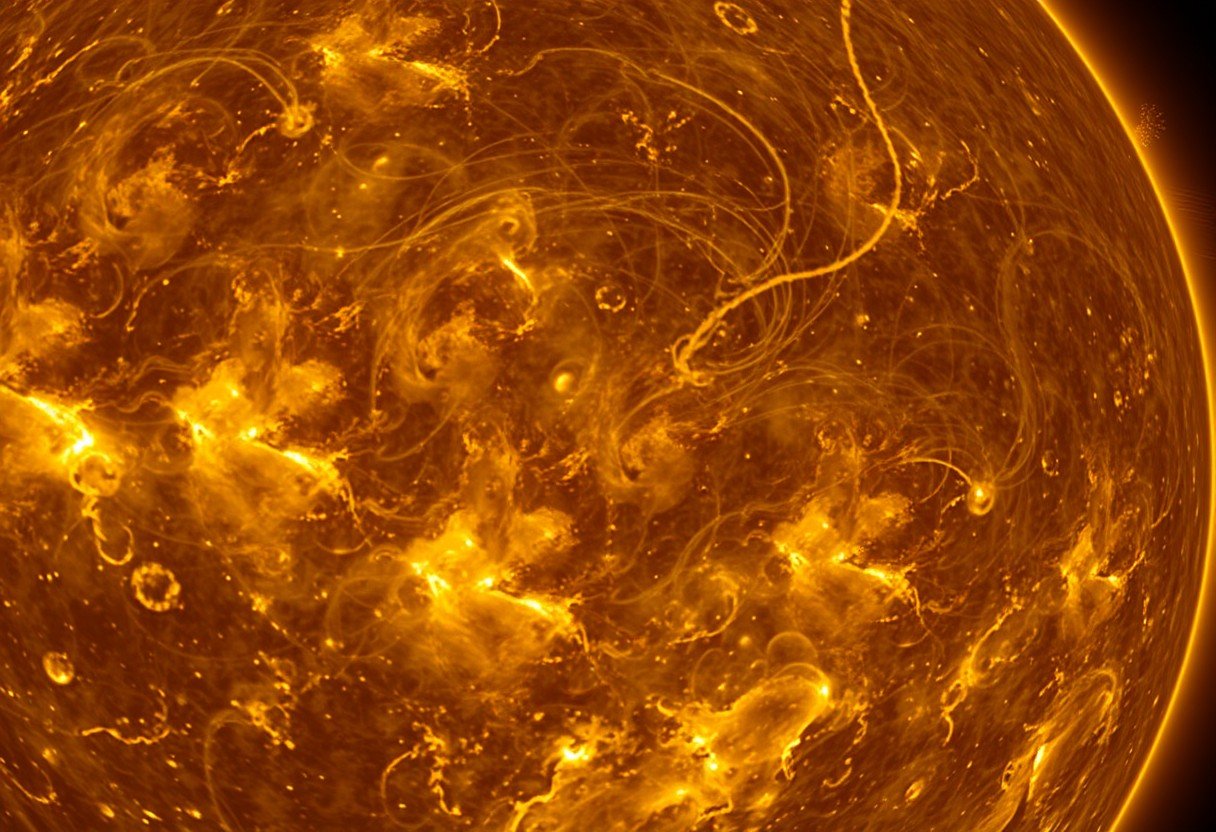The Sun is a giant, dynamic ball of hot gas, not a solid object. The incredible energy it produces travels from its core to its surface through different layers. This energy moves through circulating currents of gases primarily in the convection zone, the Sun’s outer layer. Understanding this process is key to knowing how the Sun powers our solar system and creates phenomena like solar flares and sunspots that can affect us here on Earth.
The Basic Structure of the Sun
To understand how energy travels, you first need to know the Sun’s layout. It is made of several distinct layers, each with a specific job in producing and transporting energy. Think of it like an onion, with each layer playing a part in the final result.
The interactions between these layers are what drive solar activity. From the core to the surface, a complex journey unfolds that ultimately releases light and heat into space.
The main layers involved in this energy transport are:
- The Core: This is the Sun’s central engine, where nuclear fusion happens.
- The Radiative Zone: A super dense region surrounding the core where energy travels very slowly.
- The Convection Zone: The outermost layer of the Sun’s interior, where energy moves through currents of hot gas.
How the Sun’s Core Creates Energy
All of the Sun’s energy begins in its core. Here, the temperature is about 15 million degrees Celsius, and the pressure is immense. These extreme conditions are perfect for a process called nuclear fusion.
During nuclear fusion, hydrogen atoms are crushed together to form helium. This process releases a massive amount of energy in the form of light and heat. This is the energy that eventually makes its way to Earth.
The balance between temperature and pressure is essential for keeping the Sun stable. This stability allows nuclear fusion to continue at a steady rate, providing a consistent source of energy for billions of years.
| Factor | Importance for Fusion |
| Temperature | Provides the energy needed for hydrogen nuclei to overcome their natural repulsion and fuse together. |
| Pressure | Keeps the core dense, increasing the chances of nuclei colliding and fusing. |
The Journey of Energy Through the Sun
Once energy is created in the core, it begins a long journey to the surface. Its first stop is the radiative zone, a tightly packed area where energy travels as photons, or light particles.
The journey through the radiative zone is incredibly slow. Photons are constantly absorbed and re-emitted by atoms, bouncing around in a random path that can take over 100,000 years to complete. It’s like trying to get through an extremely dense crowd.
After finally clearing the radiative zone, the energy enters the convection zone, where its trip speeds up dramatically. Here, the method of transport changes from radiation to convection.
A Closer Look at the Convection Zone
The convection zone is the vast outer layer of the Sun’s interior, stretching about 200,000 kilometers from near the surface inward. In this region, energy is transported by the physical movement of hot gas.
The process is similar to a pot of boiling water on a stove. Hot, less dense plasma at the bottom of the zone rises toward the surface. As it reaches the top, it cools, becomes denser, and sinks back down to get reheated.
This constant circulation of gas, known as convection currents, efficiently carries heat to the Sun’s surface. From there, the energy is released into space as the light and heat that we experience on Earth.
What are Convection Cells?
The rising and sinking of gas in the convection zone creates cell-like patterns on the Sun’s surface, which is called the photosphere. These patterns are known as granules.
If you could look at the Sun’s surface up close, you would see it has a grainy texture. Each of these “grains” is the top of a convection cell. Hot gas rises in the bright center of a granule, while cooler gas sinks along the darker edges.
These granules are huge, often about 1,000 kilometers across, but they only last for a few minutes before being replaced by new ones. This constant churning is a visible sign of the powerful convection happening just below the surface.
How Convection Affects Solar Weather
The movement of gas in the convection zone does more than just transport heat. It also plays a vital role in creating the Sun’s magnetic fields. The churning motion of the electrically charged gas acts like a dynamo, generating powerful magnetic activity.
Sometimes, these magnetic fields become twisted and tangled. This can lead to dramatic solar events that impact the entire solar system.
This solar activity includes:
- Sunspots: Dark, cooler areas on the Sun’s surface caused by intense magnetic fields poking through.
- Solar Flares: Sudden, massive bursts of energy and light that erupt from the Sun’s surface.
- Coronal Mass Ejections (CMEs): Giant clouds of solar plasma that are blasted into space.
When these events are aimed at Earth, they can disrupt satellite communications, power grids, and navigation systems. This is why scientists closely monitor solar weather.
Why This Matters for Science
Studying the Sun’s convection zone is not just about understanding our own star. It provides a crucial model for understanding the behavior of other stars throughout the universe. Many stars have convection zones, and the principles that govern our Sun apply to them as well.
By observing these energy currents, astronomers can learn more about stellar stability, magnetic fields, and the life cycles of stars. This knowledge helps us build a more complete picture of how the cosmos works. It connects the processes happening inside a star to its appearance and its influence on any surrounding planets.
Frequently Asked Questions
In which layer of the Sun do circulating gases move energy?
Energy is moved by circulating currents of gases in the convection zone. This is the outermost layer of the Sun’s interior, located just below the visible surface.
What are the circulating gas currents in the Sun called?
These movements are called convection currents. They are formed when hot, less dense gas rises to the surface, cools off, and then sinks back down to be reheated, creating a continuous cycle.
How is the convection zone different from the radiative zone?
The main difference is how they transport energy. The radiative zone moves energy through photons, which is a very slow process. The convection zone moves energy through the physical circulation of hot gas, which is much faster and more efficient.
Does the convection zone cause sunspots?
Yes, the turbulent motion of gas in the convection zone generates the Sun’s powerful magnetic fields. Sunspots are areas where these magnetic fields become highly concentrated and poke through the surface.
How hot is the Sun’s convection zone?
The temperature in the convection zone varies with depth. It is about 2 million degrees Celsius at the bottom where it meets the radiative zone, and it cools to about 5,500 degrees Celsius at the top near the visible surface.









Leave a Comment